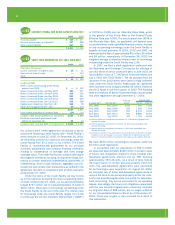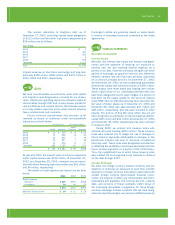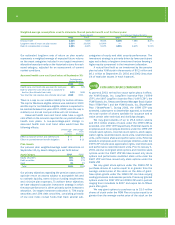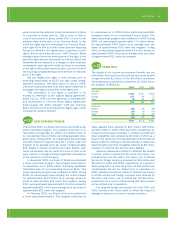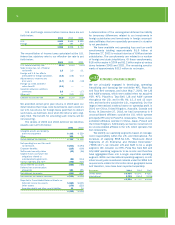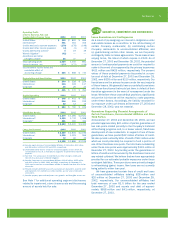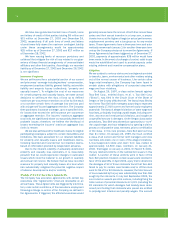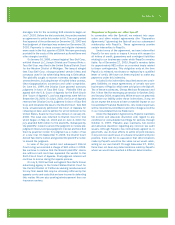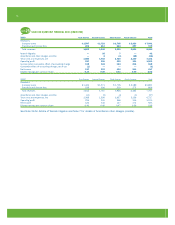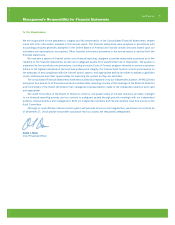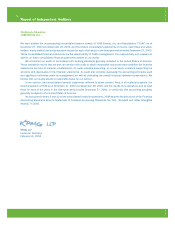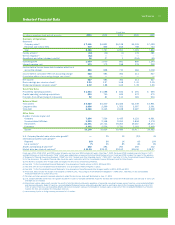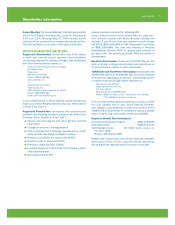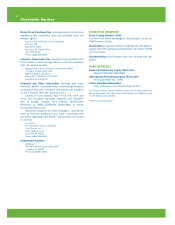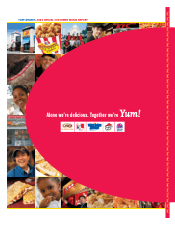Pizza Hut 2003 Annual Report Download - page 74
Download and view the complete annual report
Please find page 74 of the 2003 Pizza Hut annual report below. You can navigate through the pages in the report by either clicking on the pages listed below, or by using the keyword search tool below to find specific information within the annual report.
72.
We have also guaranteed certain lines of credit, loans
and letters of credit of third parties totaling $8 million and
$15 million at December 27, 2003 and December 28,
2002, respectively. If all such lines of credit and letters
of credit were fully drawn the maximum contingent liability
under these arrangements would be approximately
$25 million as of December 27, 2003 and $27 million as
of December 28, 2002.
We have varying levels of recourse provisions and
collateral that mitigate the risk of loss related to our guar-
antees of these financial arrangements of unconsolidated
affiliates and other third parties. Accordingly, our recorded
liability as of December 27, 2003 and December 28, 2002
is not significant.
Insurance Programs
We are self-insured for a substantial portion of our current
and prior years’ coverage including workers’ compensation,
employment practices liability, general liability, automobile
liability and property losses (collectively, “property and
casualty losses”). To mitigate the cost of our exposures
for certain property and casualty losses, we make annual
decisions to self-insure the risks of loss up to defined
maximum per occurrence retentions on a line by line basis
or to combine certain lines of coverage into one loss pool
with a single self-insured aggregate retention. The Company
then purchases insurance coverage, up to a specified limit,
for losses that exceed the self-insurance per occurrence
or aggregate retention. The insurers’ maximum aggregate
loss limits are significantly above our actuarially determined
probable losses; therefore, we believe the likelihood of
losses exceeding the insurers’ maximum aggregate loss
limits is remote.
We are also self-insured for healthcare claims for eligible
participating employees subject to certain deductibles and
limitations. We have accounted for our retained liabilities
for property and casualty losses and healthcare claims,
including reported and incurred but not reported claims,
based on information provided by independent actuaries.
Due to the inherent volatility of actuarially determined
property and casualty loss estimates, it is reasonably
possible that we could experience changes in estimated
losses which could be material to our growth in quarterly
and annual net income. We believe that we have recorded
reserves for property and casualty losses at a level which
has substantially mitigated the potential negative impact
of adverse developments and/or volatility.
Change of Control Severance Agreements
The Company has severance agreements with certain key
executives (the “Agreements”) that are renewable on an
annual basis. These Agreements are triggered by a termina-
tion, under certain conditions, of the executive’s employment
following a change in control of the Company, as defined in
the Agreements. If triggered, the affected executives would
generally receive twice the amount of both their annual base
salary and their annual incentive in a lump sum, a propor-
tionate bonus at the higher of target or actual performance,
outplacement services and a tax gross-up for any excise
taxes. These Agreements have a three-year term and auto-
matically renew each January 1 for another three-year term
unless the Company elects not to renew the Agreements. If
these Agreements had been triggered as of December 27,
2003, payments of approximately $38 million would have
been made. In the event of a change of control, rabbi trusts
would be established and used to provide payouts under
existing deferred and incentive compensation plans.
Litigation
We are subject to various claims and contingencies related
to lawsuits, taxes, environmental and other matters arising
out of the normal course of business. Like certain other
large retail employers, the Company has been faced in
certain states with allegations of purported class-wide
wage and hour violations.
On August 29, 1997, a class action lawsuit against
Taco Bell Corp., entitled Bravo, et al. v. Taco Bell Corp.
(“Bravo”), was filed in the Circuit Court of the State of
Oregon of the County of Multnomah. The lawsuit was filed by
two former Taco Bell shift managers purporting to represent
approximately 17,000 current and former hourly employees
statewide. The lawsuit alleged violations of state wage and
hour laws, principally involving unpaid wages including over-
time, and rest and meal period violations, and sought an
unspecified amount in damages. Under Oregon class action
procedures, Taco Bell was allowed an opportunity to “cure”
the unpaid wage and hour allegations by opening a claims
process to all putative class members prior to certification
of the class. In this cure process, Taco Bell paid out less
than $1 million. On January 26, 1999, the Court certified
a class of all current and former shift managers and crew
members who claim one or more of the alleged violations.
A Court-approved notice and claim form was mailed to
approximately 14,500 class members on January 31,
2000. Trial began on January 4, 2001. On March 9, 2001,
the jury reached verdicts on the substantive issues in this
matter. A number of these verdicts were in favor of the
Taco Bell position; however, certain issues were decided in
favor of the plaintiffs. In April 2002, a jury trial to determine
the damages of 93 of those claimants found that Taco Bell
failed to pay for certain meal breaks and/or off-the-clock
work for 86 of the 93 claimants. However, the total amount
of hours awarded by the jury was substantially less than that
sought by the claimants. In July and September 2002, the
court ruled on several post-trial motions, including fixing the
total number of potential claimants at 1,031 (including the
93 claimants for which damages had already been deter-
mined) and holding that claimants who prevail are entitled
to prejudgment interest and penalty wages. The second


